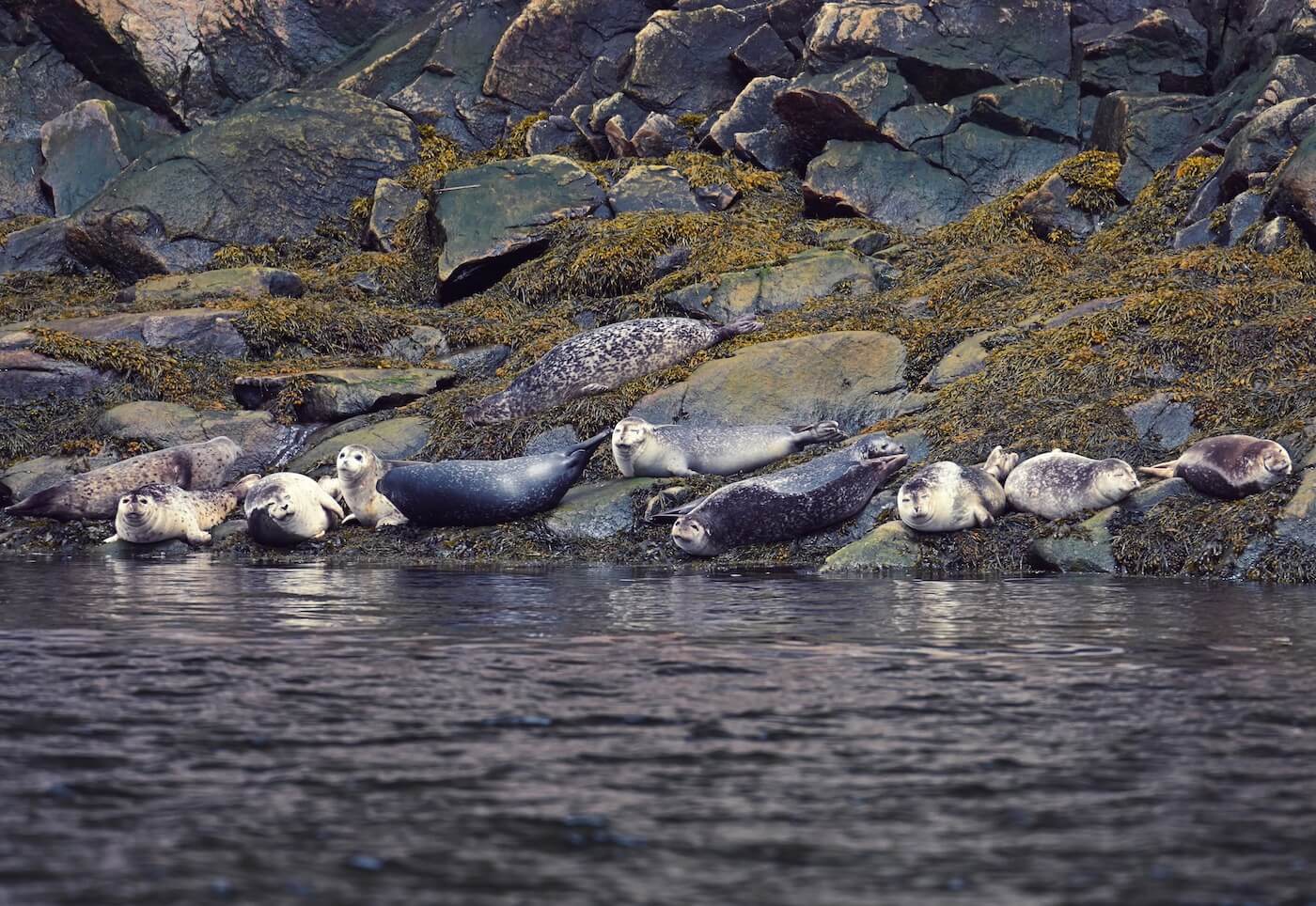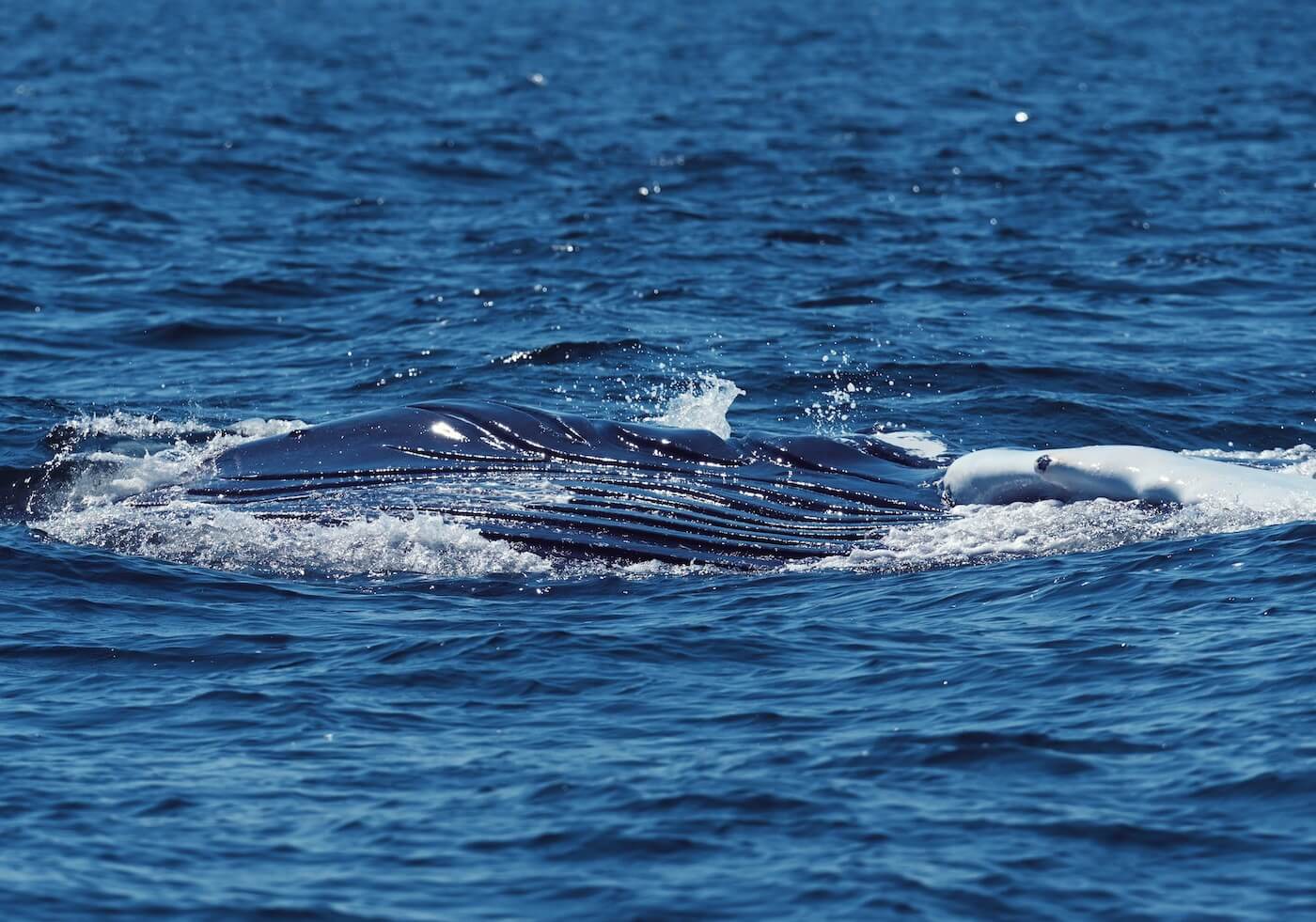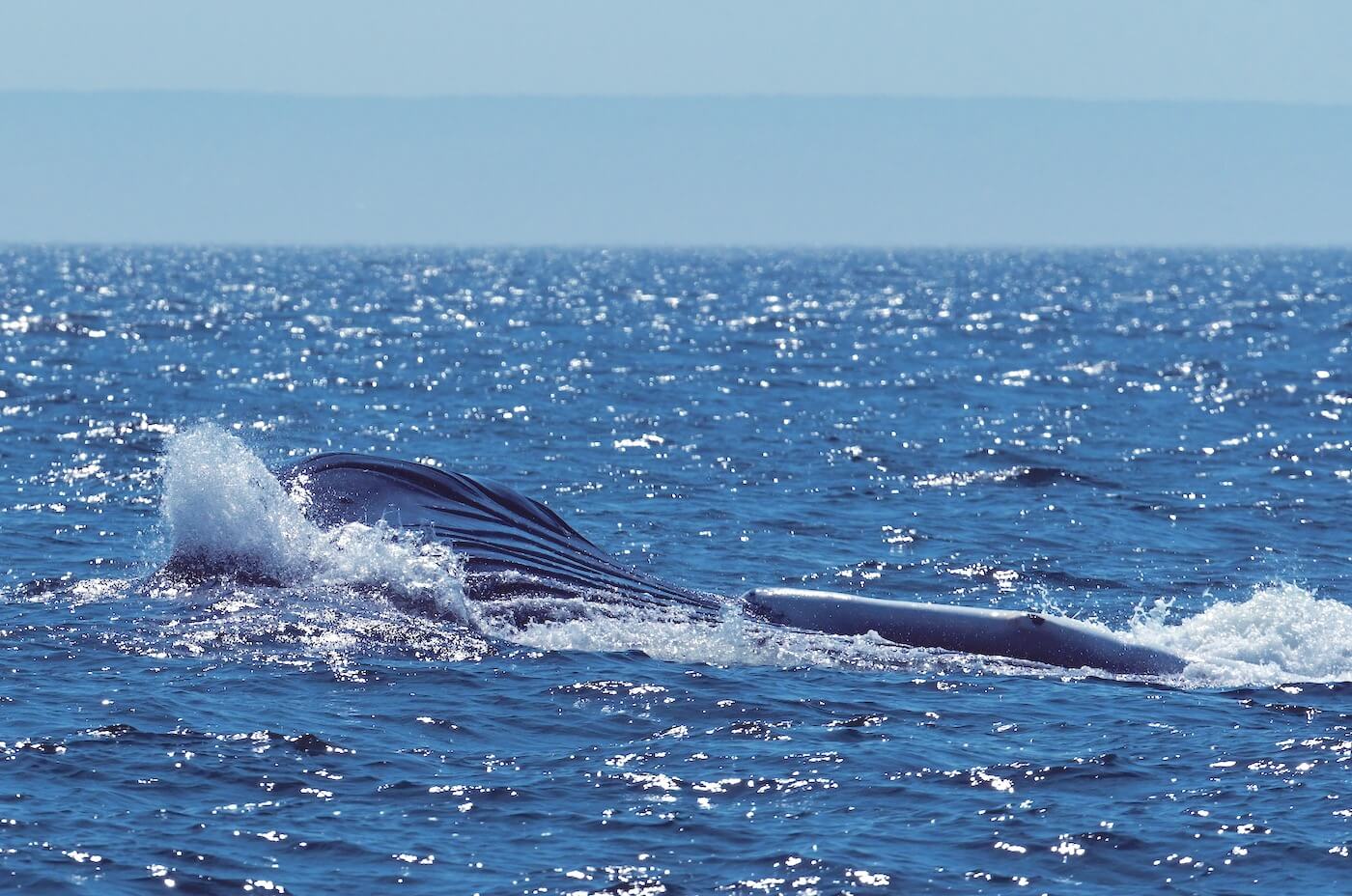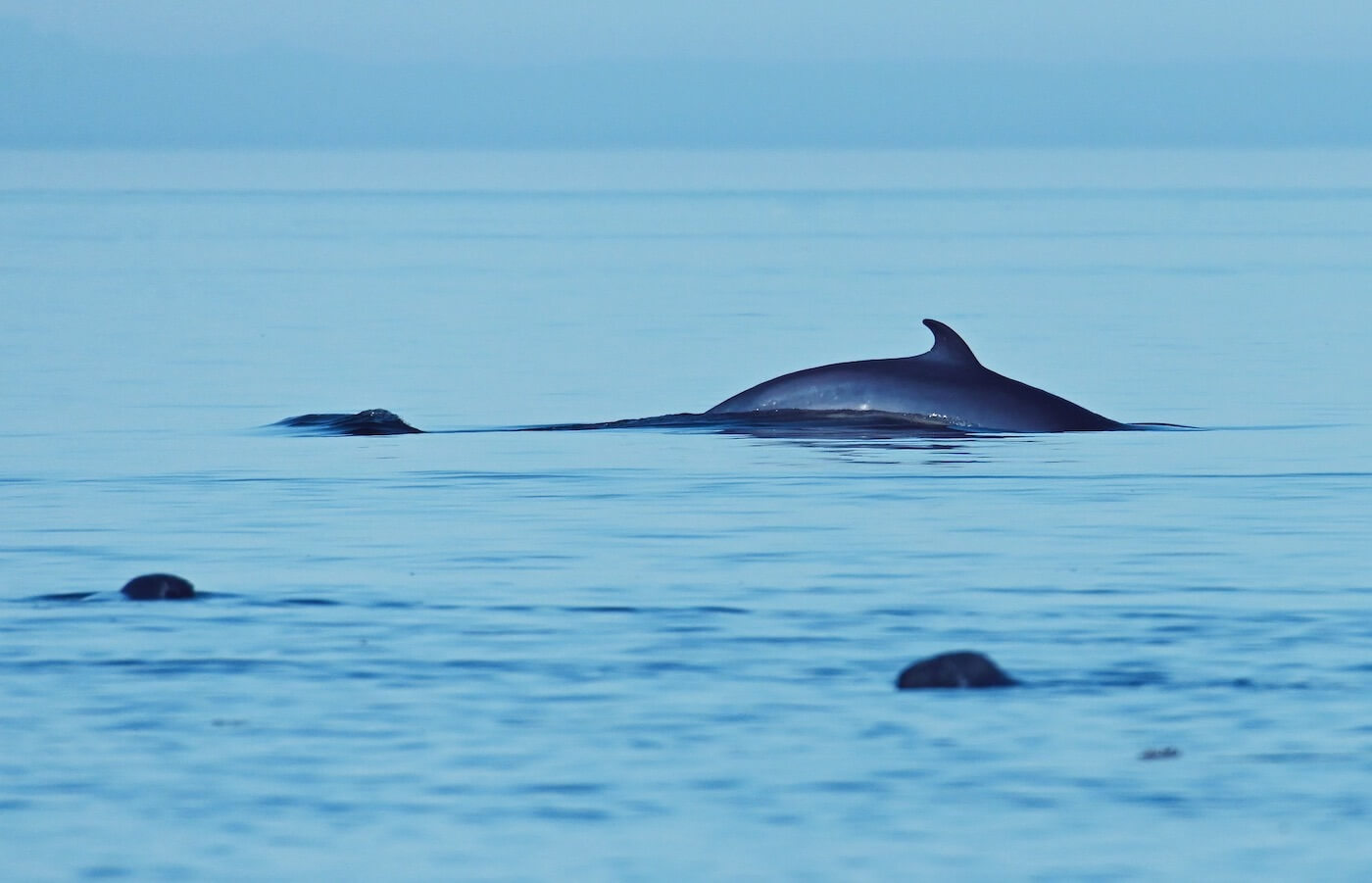Whether it’s the glistening white backs of belugas in the estuary, abundant minke whales, or the humpback whale Irisept eating her fill, the variety of sightings in the St. Lawrence is growing by the day! To admire these giants of the seas in a completely peaceful environment, the shore is often the perfect place.
The Côte-Nord region, as well as a few locations in the Gaspé Peninsula and the Bas-Saint-Laurent region can all be great for observing whales directly from shore, with or without binoculars. At certain sites, there’s even the possibility that experienced naturalists will be present to answer our questions.
Plunging into the world of whales
From Tadoussac to Les Escoumins, where the sea floor abruptly drops several hundred metres, whales sometimes come very close to the shore! A multitude of prime viewing locations can therefore be found here.
There is no shortage of marine mammals in Tadoussac. A minke whale was spotted from Pointe de l’Islet on Monday evening while a few belugas were seen a little farther away. The following day, another minke whale ventured into Tadoussac Bay. From the Marine Mammal Interpretation Centre, there are reports of a minke whale and a nearby beluga that were exhibiting some curious behaviours: “The two of them were swimming in circles,” describes the naturalist. Impossible to tell if they were interacting, but it was certainly interesting to watch!” In the Saguenay Fjord, dozens of harbour seals were resting peacefully on the rocks.
Seeing marine mammals from land-based observation sites requires a combination of patience and luck. In other words, you have to be in the right place at the right time! Many sightings are simply a question of chance. In Les Bergeronnes, the rocks of the Cap de Bon-Désir Interpretation and Observation Centre provide a breathtaking view of the river. Throughout the week, fin whales, minke whales, harbour porpoises and belugas have all been present.
The Marine Environment Discovery Centre, in Les Escoumins is another ideal place for watching wildlife. Minke whales and belugas were passing through this week. “There were around ten belugas this morning,” reports one local, “near the coast and about two kilometres upriver from the docks! Fortunately they were close, because we could only see two kilometres offshore because of the fog.”
Large rorquals
In the estuary, it seems that food is plentiful at the surface! The humpback whale Irisept was observed feeding for several minutes. A naturalist shares this unique observation: “We could see the krill swarming at the surface! We could also see [her] mouth wide open, the extended ventral grooves, and the clearly visible baleen… She rolled onto her side (always to the right) and we were able to see large portions of her tail and parts of her huge pectoral fins… It was magical…” Fin whales, several of which have been tallied in the estuary in recent days, also cashed in on the buffet. Offshore, harp seals and grey seals have also been present in large numbers.
Spouts of the world’s largest cetacean, a blue whale, were spotted in Franquelin. A leaping bluefin tuna as well as the presence of a few porpoises and minke whales complete the picture for this sector. Between Matane and Pointe-des-Monts, dozens of white whales and porpoises were seen when the fog lifted.
Using one’s senses to search for whales
“Today the fog lifted,” begins one experienced observer, “we had some yesterday and again this morning. When the fog is heavy, my technique is to rely on my ears rather than on my eyes.” By heading to the cove known as Anse Saint-George to search for whales in Gaspé Bay at the break of dawn, he is able to enjoy some early morning tranquillity. “I was lucky… Very close to me, there were big blasts as well as some smaller spouts. I figured they were probably humpbacks and minke whales.” Several humpbacks, multiple minke whales as well as fin whales were observed in the area.
Combining hiking with whale watching
By watching whales from shore, you can combine several activities at once! Whether you’re enjoying a picnic, hiking or simply lazing at the water’s edge, a few breaks to gaze out to sea are all you need to admire the region’s marine fauna. But when a whale finally skirts along the coast, enchantment awaits you! During a stroll at Cap Ferré, one avid cetacean enthusiast was blown away: “A dozen or so marine mammals, including fin whales and porpoises, all feeding. I was quivering with joy.”
Preparing for a whale-watching trip is much the same as getting ready for any outdoor activity: bring food and drink, know where you’re going and have the right gear should the weather take a turn for the worse. Since it is often a little cooler near the water, it’s a good idea to pack warm clothes in case the temperature drops. Binoculars are useful for spotting movement in the water from a distance. It’s not always easy to identify the species from afar! It’s also wise to keep field guides for marine mammals and birds handy, since you never know what kinds of animals you might encounter.
Where are the whales this week? Observation map
These data were reported by our network of observers. They give an idea of the presence of whales and in no way represent the actual distribution of whales in the St. Lawrence. Just for fun!
Click on the whale or seal icons to discover the species, the number of individuals, additional information or photos of the sighting. To enlarge the map, click on the icon in the top right-hand corner. The map works well on Chrome and Firefox, but not so well on Safari.
To display the list of sightings, click on the icon in the top left-hand corner.
Thanks to all our collaborators!
Special thanks go out to all our observers who share their love for marine mammals with us! Your encounters with cetaceans and pinnipeds are always a pleasure to read and discover.
On the water or from shore, it is your eyes that give life to this column.
Odélie Brouillette
Marie-Andrée Charleboix
Thalia Cohen-Bacry
Laetitia Desbordes
Véronique Gélinas
Audrey Hébert
Diane Ostiguy
Jade-Audrey Lavergne
Kevin Maltese-Crottier
Yael Medav
Élizabeth Melis
Chloé Pazart
Renaud Pintiaux
Pascal Pitre
Christine Stadelmann
Jean Roy
René Roy
Andréanne Sylvain
Marielle Vanasse
Additionally, we would like to acknowledge the following teams that also share their sightings:
Sept-Îles Research and Education Centre (CERSI)
Group for Research and Education on Marine Mammals (GREMM)
Marine Mammal Observation Network (MMON)
Quebec Marine Mammal Emergency Response Network (QMMERN)
Mingan Island Cetacean Study (MICS)
Would you also like to share your observations?
Have you seen any marine mammals in the St. Lawrence? Whether it’s a spout offshore or just a couple of seals, drop us a line and send your photos to [email protected]!









